Fluorescence is one of the most misunderstood aspects of diamonds. Some buyers avoid it like the plague, while others see it as a hidden gem, literally. But is diamond fluorescence really good or bad?
It often depends on who you ask. There are purists who only go for the highest, clearest, and brightest stones, avoiding fluorescence entirely. Then there are the unconventionalists who think the soft blue glow under UV light adds character and a touch of magic.
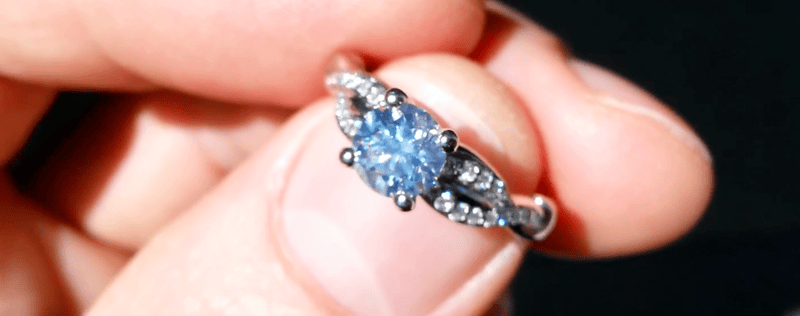
The internet doesn’t help either. Some jewelers warn against fluorescence entirely, while others claim it’s the best-kept secret for saving money without sacrificing beauty.
As with most things in the diamond world, the truth is more nuanced. In this guide, I’ll explain what fluorescence actually is, how it can affect a diamond’s appearance and value, and how to make it work in your favor.
What is Diamond Fluorescence
Diamond fluorescence refers to how a diamond reacts when exposed to ultraviolet (UV) light. UV light is present in everyday settings like sunlight, fluorescent lighting, and even in nightclubs with black lights.
Some diamonds contain trace elements such as nitrogen, boron, or aluminum within their crystal structure. When exposed to UV light, these elements absorb the energy and shift into a higher energy state. To return to stability, they release that excess energy in the form of visible light. This glow is what we call fluorescence.
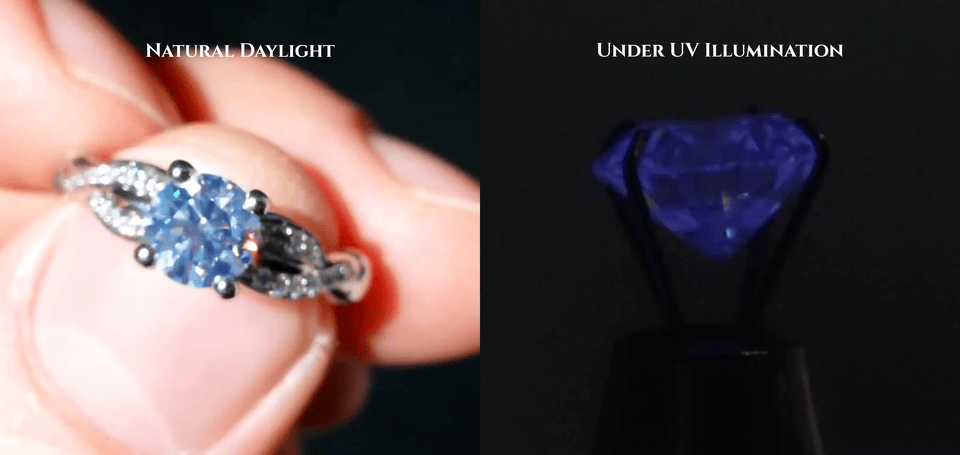
In most cases, the fluorescence appears as a soft blue hue, which accounts for roughly 98% of fluorescent diamonds. Less commonly, the glow may be white, yellow, green, or even pink. The color and strength of fluorescence depend entirely on the diamond’s internal atomic arrangement and the specific elements present.
While fluorescence is invisible under normal lighting, it can influence how a diamond looks in certain conditions, especially under direct sunlight. For some diamonds, this effect can enhance their beauty, while in others it might make them appear slightly hazy or milky. That’s why understanding fluorescence is essential if you want to make the most informed choice.
Understanding Diamond Fluorescence Levels
Diamond fluorescence is graded on a scale based on how strongly a diamond glows under ultraviolet (UV) light. This scale is determined by gemological laboratories like GIA and AGS, and it ranges from None to Very Strong. These levels describe the intensity of the visible fluorescence and are helpful indicators of how much a diamond might visually change under UV exposure.
There are five standard fluorescence levels:
1. None
The diamond shows no measurable reaction to UV light. Most high-end diamonds fall into this category, and many traditional buyers prefer this for peace of mind, even though fluorescence is not always bad.
2. Faint
Only a very slight fluorescence is present under UV light, typically not visible to the naked eye in any normal lighting condition. This level never causes haziness and can be a smart value option in near-colorless diamonds (G color or higher), as it often comes with a slight price discount.

3. Medium
A clearly visible glow under UV light, usually blue. This level still doesn’t typically affect the appearance in everyday lighting. In fact, medium blue fluorescence can make diamonds in the H to K color range appear slightly whiter, especially in outdoor sunlight.
4. Strong
At this level, the blue glow under UV light becomes very noticeable. Some diamonds with strong fluorescence remain unaffected in appearance, while others can show signs of haziness or a milky look, particularly if they are in the colorless range (D to F). Inspection is essential.
5. Very Strong
The diamond emits a very intense blue glow under UV exposure. This level is the most likely to cause visual issues such as cloudiness, especially in diamonds with high color grades. Unless inspected thoroughly, these diamonds should be chosen with caution.
How Fluorescence Affects Appearance and Value
Not all fluorescence is created equal. While the grading report tells you the intensity level, it does not reveal how the diamond will actually look in person. That is because fluorescence can sometimes have no visible impact at all, or in other cases, it can make a diamond appear slightly cloudy or hazy and this haziness may become more noticeable in natural sunlight where fluorescence is subtly activated.
At the same time, certain levels of blue fluorescence can improve a diamond’s appearance under UV-containing light (such as natural daylight) by giving off a subtle blue glow that helps mask yellow undertones in lower color grades. And since many buyers automatically avoid fluorescence, diamonds that have it are often priced lower, even when their visual performance is just as strong.
If you like the idea of a subtle blue glow or do not mind it, then the only real concern is whether the diamond appears hazy. Fluorescence alone is not a defect and in fact, it can be a hidden advantage. As long as the diamond looks clear and brilliant in regular lighting, even strong or very strong fluorescence can offer excellent value without any downside.
Even according to the Gemological Institute of America (GIA), for the average observer, strong blue fluorescence has little to no effect on a diamond’s transparency and in some cases, it may even enhance the stone’s color appearance, especially in lower color grades.
To help you make sense of it, here is a clear breakdown of how each level of diamond fluorescence affects appearance, value, and which color grades it works best with:
| Fluorescence Grade | Risk of Haziness | Best for Color Grades | Price Advantage |
|---|---|---|---|
| None | None | D to J | None |
| Faint | None | D to G | Small savings |
| Medium | Rare | H to K | Moderate savings |
| Strong | Sometimes | J and lower | Good savings |
| Very Strong | Often | J and lower (inspect!) | High savings |
As you can see, the impact of fluorescence depends heavily on its intensity and the diamond’s color grade. But while the chart gives a general overview, judging a diamond’s haziness still requires visual inspection. That is where high-definition video tools come into play, especially if you are considering diamonds with strong or very strong fluorescence.
Pro tip:
Diamond grading reports tell you the fluorescence strength, but not how it affects the diamond’s actual appearance. That’s why it is important to inspect the diamond closely under neutral lighting using HD 360° video, especially when fluorescence is strong or very strong. Even though most vendors do not show how a diamond looks under UV or direct sunlight, you can still spot signs of haziness or a milky appearance if they are noticeable enough.
James Allen and Blue Nile are the two best platforms for this kind of evaluation. Both offer 40x magnification and 360° HD viewing, making it easier to filter out fluorescent diamonds that might look cloudy or dull. For a more guided experience, try James Allen’s Real Time Diamond Inspection, where you can zoom, rotate, and speak live with a gemologist in just a few seconds.
When Faint Fluorescence Is a Smart Choice
Obviously, “None” refers to the absence of fluorescence, so the presence of this feature starts with “Faint”. Diamonds graded with faint fluorescence are never hazy. Meaning, you can always take a diamond with faint fluorescence and it will not make any difference. This grade is best with a G or higher color as it can save you money without losing the diamond’s overall brilliance.

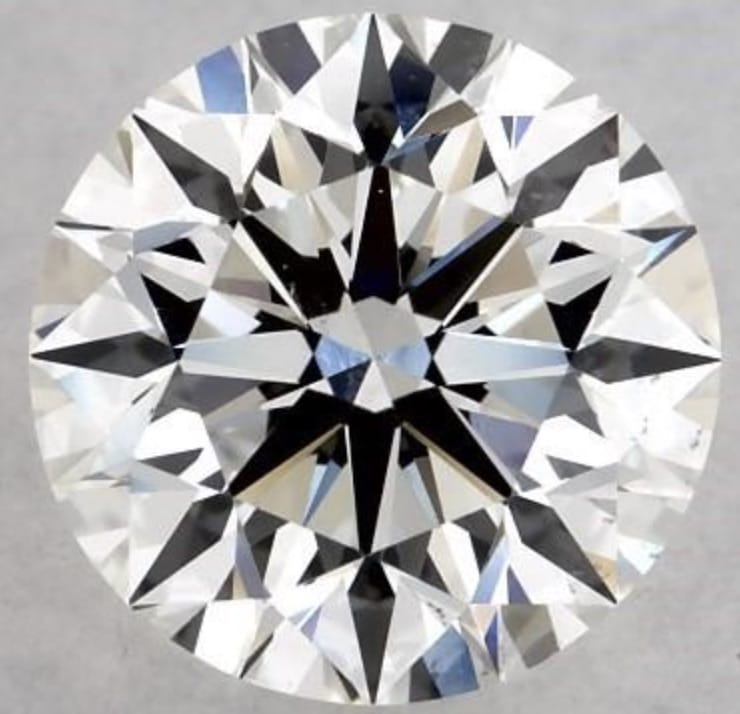
Both of these diamonds are 1.00 carat, F color, and VS2 clarity. The one on the left has faint fluorescence and is approximately 20% less expensive than the one on the right, which has none. Yet visually, they are virtually identical. For most buyers, faint fluorescence is a smart choice that offers savings without any compromise in appearance or performance, unless you specifically want to avoid fluorescence altogether.
Should You Consider Medium Blue Fluorescence?
Diamonds in this level of fluorescence are usually not hazy. As I explain in my guide on diamond color, medium blue fluorescence is worth considering for H to K color graded diamonds.
Since the fluorescence glow is typically blue and blue is complementary to yellow it can visually counteract warm undertones in lower color diamonds, making them appear whiter. This is especially noticeable in sunlight or UV-rich environments, but even in regular indoor lighting, some buyers find the diamond appears slightly brighter or cooler in tone. While the glow itself may not always be visible without UV exposure, the overall impression of a whiter diamond often remains.
To see this effect in action, here’s a comparison of two GIA-graded J color diamonds with similar specs. The one on the left has medium blue fluorescence, while the one on the right has none:

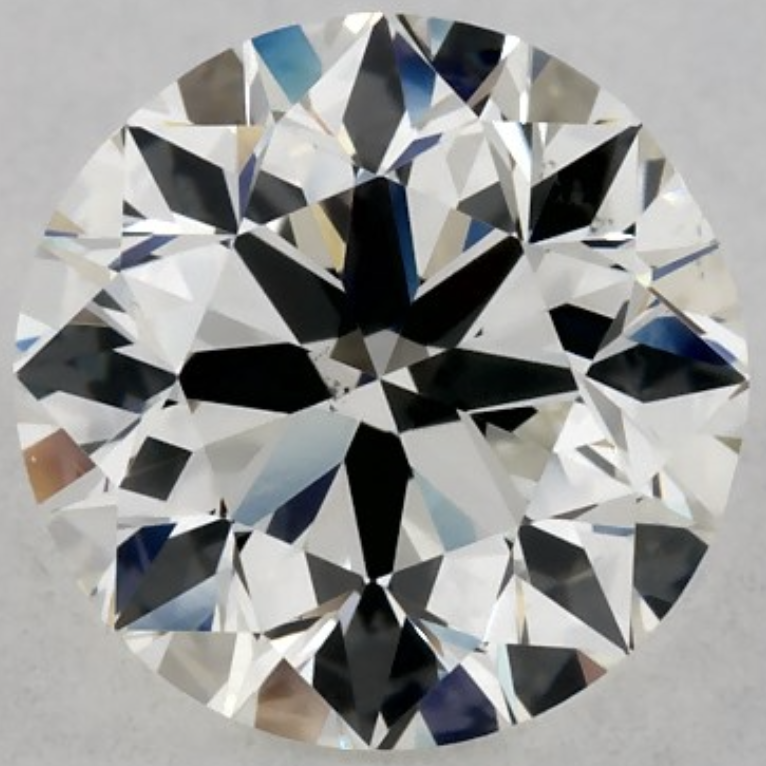
The diamond with medium fluorescence appears slightly brighter and cooler, making it a smart option for buyers looking to offset the natural warmth of a J color without increasing their budget.
This is where medium blue fluorescence really shines, it hits the sweet spot between visual enhancement and minimal risk, especially in I to K color grades where a little extra brightness goes a long way.
Is Strong or Very Strong Fluorescence Risky?
Strong and very strong blue fluorescence can sometimes create a hazy or milky appearance in a diamond, especially in higher color grades like D to F. These color grades do not have enough warmth to counterbalance the intense blue glow, which can disrupt the diamond’s transparency and brightness.
Because of this, I do not recommend buying a diamond with strong or very strong fluorescence without inspecting it first. You’ll want to look for any signs of cloudiness, especially in direct light or neutral lighting conditions.
Let’s take a look at a real-world example of why inspecting strong fluorescent diamonds is so important especially in high color grades like D.
Below, you’ll see two diamonds side by side. Both are D color, VS2 clarity, and around 1 carat. On paper, they are virtually identical. But there’s one key difference:
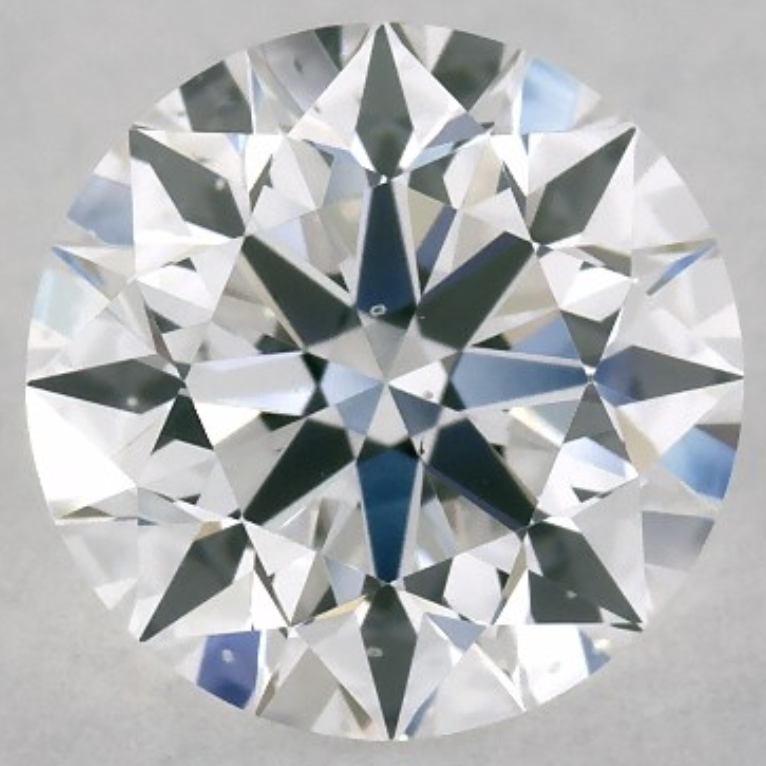
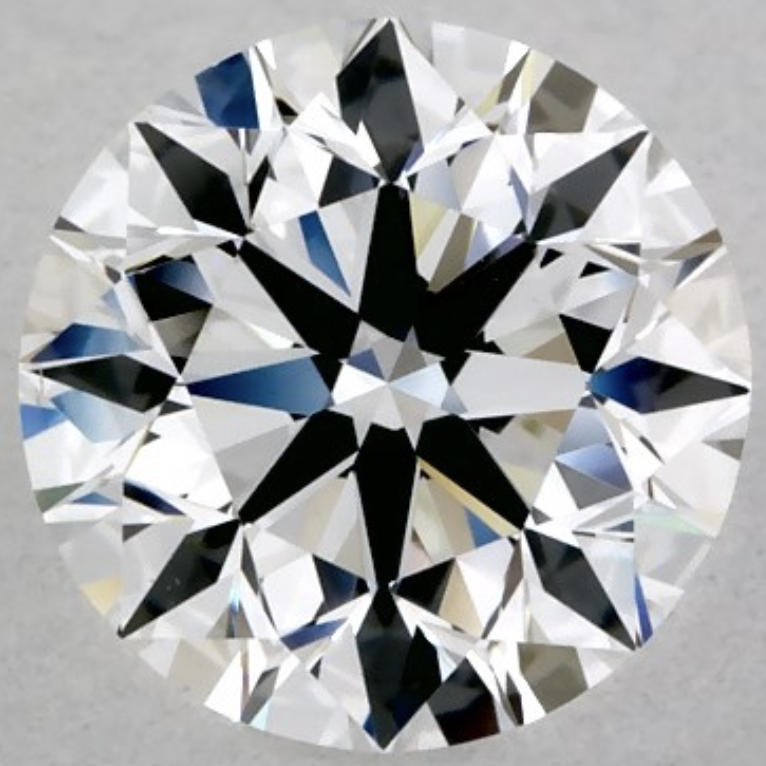
At first glance, the diamond on the left appears less crisp. There is a subtle milky layer across the facets that slightly dulls the contrast. This is what gemologists refer to as haziness, and it’s a known risk when strong fluorescence is paired with high color grades like D or E, which don’t have enough warmth to visually balance the glow.
In contrast, the diamond on the right looks crystal clear. You can easily see the sharp reflections, and the internal structure of the diamond is clearly defined just as you’d expect from a premium D color gem.
This comparison highlights an important truth:
Strong fluorescence in a high color grade can result in haziness but not always. You need to inspect each diamond carefully using high-resolution video.
And when in doubt, stick to faint or medium fluorescence if you’re shopping for a D to F color diamond. You’ll still get the cost benefit without risking the visual trade-off.
While haziness is the main concern in higher color grades, fluorescence can also have a major impact on price even when the diamond looks perfectly clean. In the next example, you’ll see just how much value you can unlock when strong fluorescence doesn’t come with any visual downside.
Let’s take a look at two James Allen True Hearts diamonds that are visually very similar on paper, both are G color, VS1 clarity, and around 1 carat:

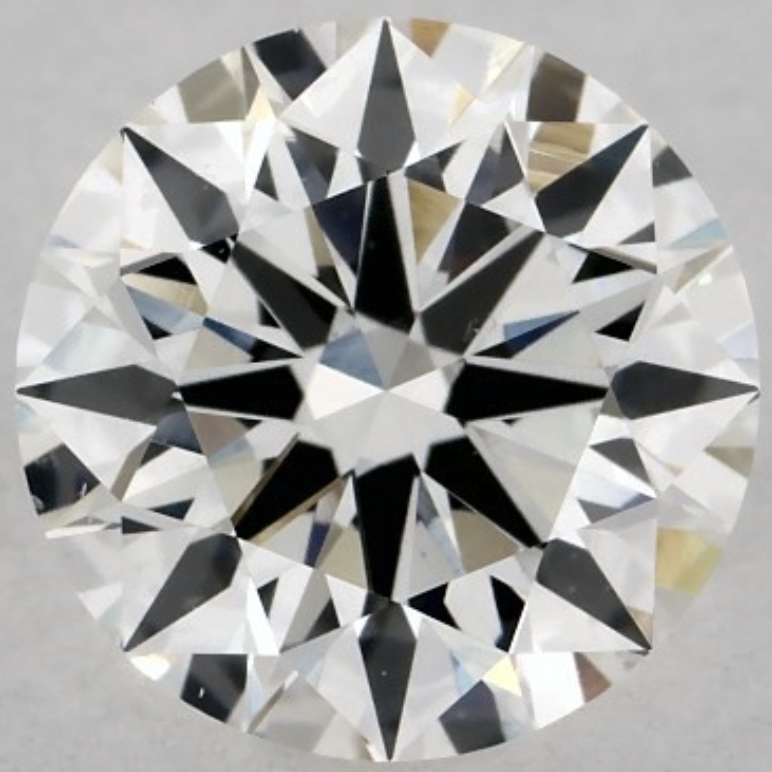
Both of these diamonds belong to James Allen’s True Hearts collection, meaning they’re cut to ideal proportions with exceptional symmetry and light performance. So logically, they should be priced about the same. But despite being nearly identical on paper, the strong fluorescent diamond on the left is $2,790 less expensive!
Here’s the surprising part:
The diamond with strong fluorescence does not show any signs of haziness. Its reflections are sharp, the hearts and arrows pattern is crisp, and the facet contrast looks clean and lively. This is a perfect example of how strong fluorescence can dramatically reduce price without sacrificing visual quality if you take the time to inspect it properly.
Now let’s move one step further and compare two more diamonds, this time both are J color and SI1 clarity. Once again, both are cut to excellent standards, but the one on the left has strong fluorescence, and the other has none.
At first glance, the difference is striking:


The diamond on the left with strong fluorescence appears noticeably brighter, with better light return and contrast. The non-fluorescent diamond on the right looks darker and warmer, particularly near the edges.
This is a classic example of when strong fluorescence can be highly desirable. In lower color grades like J, the diamond has a slightly warm tone by default. The cool blue effect of strong fluorescence can help mask that warmth, making the diamond appear whiter and livelier especially under sunlight, and even in regular indoor lighting. Beyond the glow itself, fluorescent diamonds also have subtle optical differences that enhance brightness and contrast, particularly in near-colorless to faintly tinted stones.
Of course, it’s still important to inspect for haziness but in this case, the strong fluorescent diamond looks crisp, bright, and extremely well-cut. It offers visual improvement and a price advantage, which makes it a smart choice for shoppers looking to stretch their budget without sacrificing appearance.
Why Blue Fluorescence Got a Bad Name
Blue fluorescence can affect a diamond negatively when it causes haziness or a milky appearance. In rare cases, this happens with diamonds that have strong or very strong fluorescence, especially in higher color grades like D to F. These diamonds may appear less transparent or slightly dull to the naked eye. When that occurs, the diamonds are sometimes referred to as over-blue diamonds, a term that still carries negative weight.
The real reason blue fluorescence earned its poor reputation dates back several decades. In the early to mid-twentieth century, diamonds with a strong blue glow were marketed as blue white diamonds. At the time, this label was used for high-quality, colorless diamonds that displayed noticeable fluorescence. These diamonds were even sold at a premium, because the blue glow was considered elegant and desirable.
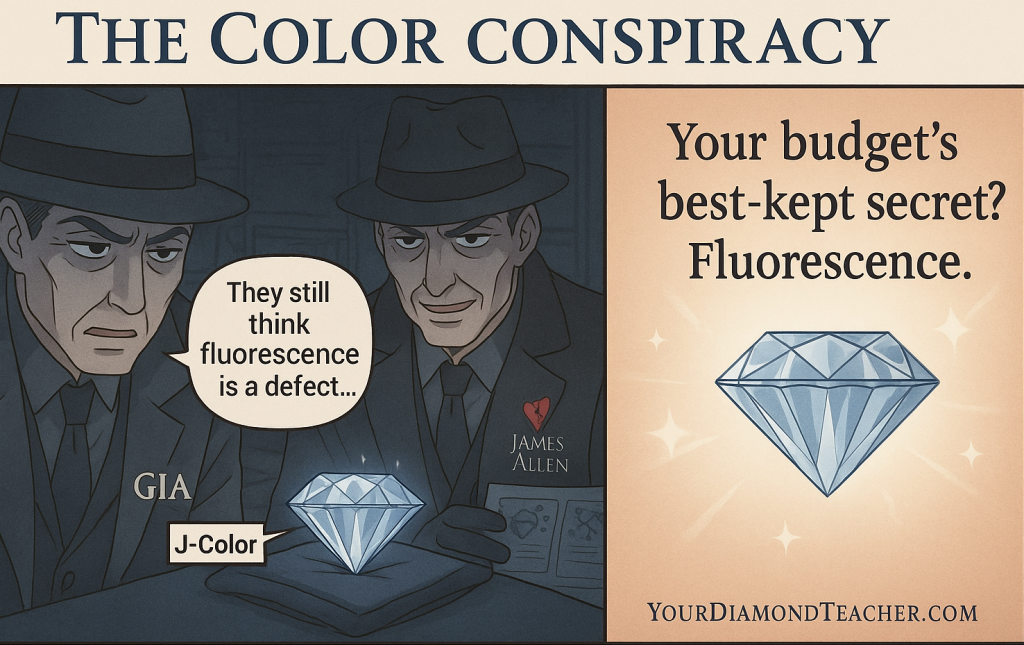
The problem started when less trustworthy sellers began using the blue white label for lower-quality diamonds that happened to fluoresce. This led to confusion, as many buyers believed they were getting top-tier diamonds based solely on the term. The misuse became so widespread that the Federal Trade Commission in the United States eventually banned the use of the term blue white in all diamond advertising.
Since then, diamonds with fluorescence have been viewed with caution by many buyers. But in truth, the reputation is mostly outdated and no longer reflects the reality of modern diamond evaluation. Most diamonds with fluorescence are perfectly clean and brilliant, and those that are not can easily be filtered out through proper inspection.
The Benefits of Blue Fluorescence
When blue fluorescence does not cause any visible haziness, it is all upside. Once you have followed the guidance above and confirmed that the diamond looks clean and brilliant, you can fully enjoy the unique advantages that fluorescence offers.
One of the most obvious benefits is the price. Diamonds with blue fluorescence are typically 10 to 15 percent more affordable than visually comparable diamonds without it. This price difference is not because the diamonds perform worse, but rather because of a long-standing market hesitation that many buyers no longer share. For shoppers who understand how to evaluate diamonds properly, this makes blue fluorescence one of the best value opportunities in the diamond world.
Another benefit is the visual experience itself. While the blue glow from fluorescence is not usually visible under everyday indoor lighting, it can appear when the diamond is exposed to natural daylight or any light source that contains UV. In those moments, the diamond takes on a subtle icy-blue glow that many people find striking and memorable. It is a rare optical feature that can make your diamond feel more personal and unique, especially when others begin to notice it outdoors or under club lighting.
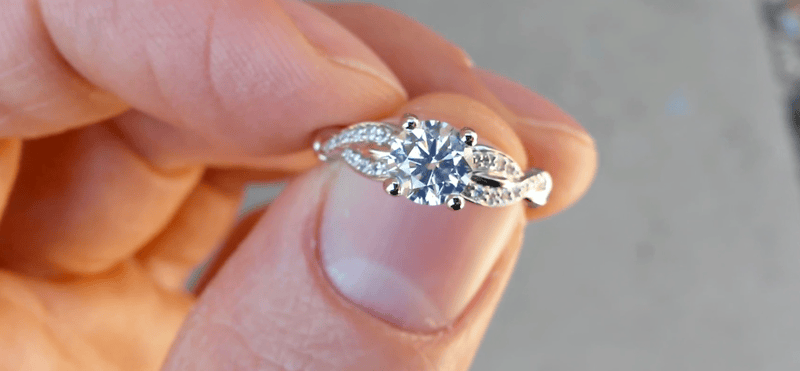
For buyers who appreciate a little character in their jewelry, blue fluorescence adds charm without any compromise in beauty. And with modern inspection tools like 360° HD video, you can confidently choose a fluorescent diamond that offers both brilliance and savings.
The Truth Behind GIA’s Fluorescence Findings
Much of the confusion surrounding diamond fluorescence comes from a widely cited study conducted by the Gemological Institute of America (GIA) in 1997. You’ll often hear sellers or blog posts claim that the study “proves” fluorescence has no effect on a diamond’s appearance. But that’s an oversimplification and the actual findings are more nuanced.
The study, titled A Contribution to Understanding the Effect of Blue Fluorescence on the Appearance of Diamonds, concluded that fluorescence had no overall negative impact on color appearance or transparency in a statistically significant way. However, this general conclusion is only part of the story.
The same study also included detailed observations that tell a more complex tale. In Figure 7 on page 256, a clear trend emerged: Diamonds with weak fluorescence were rated as more transparent than those with strong fluorescence. While this wasn’t framed as a definitive result, it strongly suggests that higher levels of fluorescence can affect the perceived clarity and brightness of a diamond, especially when compared side-by-side.

Even more telling is the fact that 50 percent of participants noticed a difference in transparency between fluorescent and non-fluorescent diamonds. That’s not a minor footnote and it shows that half of all observers could see a distinction, even if the differences were subtle.
You can view the original study here:
👉 GIA 1997 Study on Diamond Fluorescence
While GIA may have concluded that fluorescence does not universally degrade appearance, the observational data clearly reveals that it can have an impact, especially when the fluorescence is strong and the diamond is being viewed under specific lighting conditions.
From personal experience and working with countless diamonds, I can tell you that fluorescence absolutely can cause haziness. Not always, but often enough to warrant attention. This is why I find the broad conclusion of the GIA report somewhat misleading if taken at face value. So, if someone tells you that GIA has proven fluorescence is harmless in all cases, you can confidently refer them to the full study and encourage them to read past the headline.
Final Thoughts: Is Diamond Fluorescence Good or Bad?
All things considered, diamond fluorescence is not something to worry about if you follow the guidelines above and take the time to inspect the diamond. In fact, when chosen with care, fluorescence can offer unique beauty and excellent value. The icy-blue glow that appears under sunlight or UV light can give your diamond a sense of depth and individuality.
Fluorescence only becomes a concern when it causes haziness, which typically happens with strong or very strong fluorescence in higher color grades like D to F. These diamonds may lack the warmth needed to balance out the intensity of the glow. That’s why it’s essential to inspect the diamond visually, ideally using high-definition 360° video and magnification tools.
When shopping for fluorescent diamonds, James Allen and Blue Nile are two of the best places to start.
James Allen offers the largest online inventory and gives you the ability to filter diamonds by fluorescence grade. You can view each diamond in 360° high definition and zoom in with 40x magnification, making it easy to spot any potential haziness before buying.
👉 Start Browsing Fluorescent Diamonds on James Allen
Blue Nile has the second largest diamond inventory and is known for its elegant ring setting collection. Whether you are looking for a timeless solitaire or a more intricate design, their setting options are some of the best online.
If you’re unsure where to start, here’s a quick decision table that shows which fluorescence levels usually work best with each diamond color grade. Use this to narrow down your options before diving into 360° inspection:
| Color Grade | Safe Fluorescence Levels | Riskier Levels (Needs Inspection) | Visual Benefit | Price Advantage |
|---|---|---|---|---|
| D–F | None, Faint | Medium, Strong, Very Strong | ❌ Minimal | ✅ Small–Moderate |
| G–H | None, Faint, Medium | Strong | ✅ Slightly whiter in sunlight | ✅ Moderate |
| I–J | Medium, Strong | Very Strong | ✅ Noticeably whiter | ✅ Good |
| K and lower | Medium, Strong, Very Strong | Safe at all levels | ✅ Helps mask warmth | ✅ Excellent |
At the end of the day, it all comes down to personal taste. Some buyers prefer the traditional look of a diamond with no fluorescence, while others appreciate the subtle glow and the price advantage that comes with it. Either way, it’s empowering to know that this once-controversial feature can actually work in your favor.